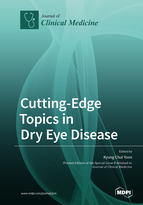Cutting-Edge Topics in Dry Eye Disease
A special issue of Journal of Clinical Medicine (ISSN 2077-0383). This special issue belongs to the section "Ophthalmology".
Deadline for manuscript submissions: closed (1 December 2020) | Viewed by 34328
Special Issue Editor
Interests: corneal and external eye disease; cataract and refractive surgery; tear film and dry eye disease; ocular pharmacology and therapeutics; aging and anti-oxidants
Special Issue Information
Dear Colleagues,
Diagnosis and treatment of dry eye disease is certainly one of the fastest evolving fields of modern ophthalmology. In recent years, multiple novel diagnosis and treatment approaches regarding dry eye disese and Meibomian gland dysfunction as well as related medical therapy have been introduced. It is not surprising that these approaches help to address clinical problems better than before, but also led to many additional questions that need to be addressed, such as biomarkers, neuropathic corneal pain, efficacy of anti-oxidative agents, and so on.
It is the aim of this Special Issue to provide an update regarding current and upcoming diagnostic and therapeutic options in the field of dry eye. Therefore, we would like to invite original research, state-of-the-art reviews, and viewpoints. In particular, we would like to encourage the submission of manuscripts covering important items regarding therapeutic agents or devices needed for an optimal long-term outcome of dry eye.
We look forward to your submissions!
Prof. Dr. Kyung Chul Yoon
Guest Editor
Manuscript Submission Information
Manuscripts should be submitted online at www.mdpi.com by registering and logging in to this website. Once you are registered, click here to go to the submission form. Manuscripts can be submitted until the deadline. All submissions that pass pre-check are peer-reviewed. Accepted papers will be published continuously in the journal (as soon as accepted) and will be listed together on the special issue website. Research articles, review articles as well as short communications are invited. For planned papers, a title and short abstract (about 100 words) can be sent to the Editorial Office for announcement on this website.
Submitted manuscripts should not have been published previously, nor be under consideration for publication elsewhere (except conference proceedings papers). All manuscripts are thoroughly refereed through a single-blind peer-review process. A guide for authors and other relevant information for submission of manuscripts is available on the Instructions for Authors page. Journal of Clinical Medicine is an international peer-reviewed open access semimonthly journal published by MDPI.
Please visit the Instructions for Authors page before submitting a manuscript. The Article Processing Charge (APC) for publication in this open access journal is 2600 CHF (Swiss Francs). Submitted papers should be well formatted and use good English. Authors may use MDPI's English editing service prior to publication or during author revisions.
Keywords
- Tear film
- Lacrimal gland
- Ocular surface inflammation
- Dry eye disease
- Meibomian gland dysfunction
- Neurosensoary abnormality
- Biomarker
- Therapeutic agent or device







